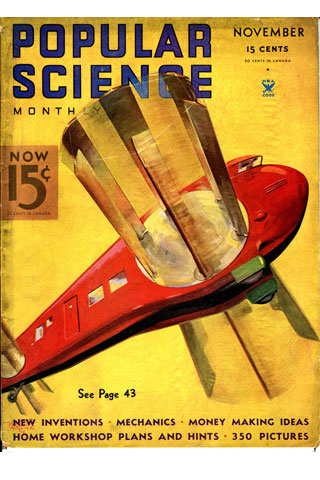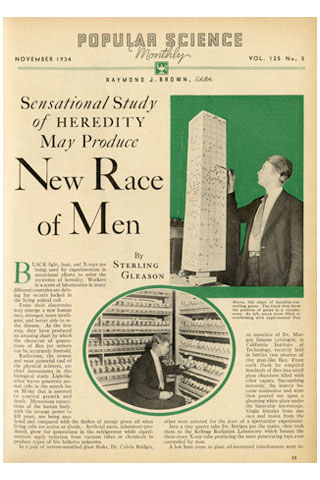Controversy
← Press coverage of Calvin in the Brooklyn Daily Eagle, December 5, 1930. It describes a “double female” bred by Bridges that “demonstrated his theory that individual sex depends on the balance maintained by male and female ‘genes’.” Courtesy of Cold Spring Harbor Laboratory Archives
Controversy – social, political, and scientific – was also a part of Calvin’s life. He was an early supporter of the nascent birth control movement, following through with his own vasectomy. Bridges’ romantic life was also an item of controversy. Ed Novitski recounts Theodosius Dobzhansky’s discussing “with relative strangers and in a joking way details of Bridges’ romantic affairs. I heard these first from Dobzhansky in 1938 in the mess hall at Cold Spring Harbor…” And Morgan, ever protective of Bridges, is famously said to have destroyed his very personal papers after this death.
Bridges’ political interests are less well known. He had an interest in the U.S.S.R. and he visited there in October of 1931 through May 1932 to lecture and then in the autumn of 1933 at the Institute of Genetics in Leningrad, where he worked with geneticist Alexandra Prokofyeva (1903–1984), who later became an assistant to H.J. Muller. In a December 2, 1931 letter home, and published in the Plattsburgh Daily Press, Bridges described speaking in a hall before 4000 people with the speech broadcast “by the state broadcasting system for all Russia.” He did not fail to mention that when he visited the Marinsky Theatre, “The girls of the ballet are handsome.” And he describes being at the November 7th anniversary of the revolution. “More than a million people were in the procession. I was given an arm band to captain the Genetics Laboratory brigade – but I was taken …to the reviewing stand so I saw it roll by at my feet. I have pictures of it, if my camera worked right… The Stand was symbolic — a huge figure of a red soldier holding back the armies of the attacking capitalist enemies.”
Right before his death, and while he was quite ill, Calvin was writing to novelist and friend Theodore Dreiser to get food and medical relief moving to the insurgent soldiers fighting Franco in the Spanish Civil War. He was particularly intent that they get supplies of brewer’s yeast to keep up their strength. Oddly, he added that “I have been raising my flies for years on no other food.” Flies and men – apparently all the same to Calvin!
On the scientific side, because Bridges was a clearinghouse of sorts for much new information about advances in the Drosophila world, especially in sending out fly stocks to other investigators; he often knew about developments before they were published. And because he was often covered in the popular press – he was a media darling of the day – he sometimes mistakenly got credit for discoveries that were not his initially, most notably the bar eyes duplication (H.J. Muller) and the discoveries about the genetic significance of Drosophila salivary gland chromosomes (T.S. Painter 1889–1969).
Muller published his findings that the bar eye was caused by a duplication of a chromosomal segment and not by a mutation in a the January 25 issue of the Bulletin of Academy of Sciences of the U.S.S.R., after presenting these findings on December 26, 1935 – he was working in the U.S.S.R. at the time. Bridges rushed his findings into the February 28, 1936 of the journal Science. The New York Times recounted the discoveries in a March 29, 1936, article “Scientist Creates New Forms of Life.” Muller believed that his results had been passed along to Bridges after he presented them in Moscow.
Time magazine in a 1936 article entitled “Genes Seen?” described Bridges’s work with salivary gland chromosomes. Theophilus Painter had discovered a staining technique that emphasized the bands on these chromosomes, which had been discovered in 1933 by two German scientists, E. Heitz and Hans Bauer. Painter, who was at the University of Texas, had hoped to keep the technique for only his use, but Muller, who was also there, picked up on the technique and trained Alexandra A. Prokofyeva in its use.
Calvin, also seeing the value of this technique, quickly improved upon it, identified these chromosomes as being polytene, and started locating genes on the giant chromosomes. Demerec, sensing the opportunity for cooperation in undertaking this massive task, wrote to Painter suggesting a collaboration. This did not sit well with Painter. He wrote to Demerec “with point-blank frankness” on October 20, 1934 that 12 members of his lab were “working literally day and night on various problems opened up by the new tool.” He thought that Demerec and Bridges should concentrate on the Drosophila Information Service instead. Demerec responded a few days later that he “would proceed with plans for a cooperation between laboratories interested in salivary gland chromosomes” and Painter could join if he wanted to. Undoubtedly Bridges was quick to realize the significance of such discoveries; and he was schooled in the Fly Room custom of sharing information freely and so was undaunted by Painter’s attempts to keep the work to himself. In 1934, Painter had mapped about 1000 bands on the salivary gland chromosomes, but Bridges had mapped 3500 bands in 1935 and thousands more in subsequent years.



